Uplifted
Thursday, October 23rd, 2014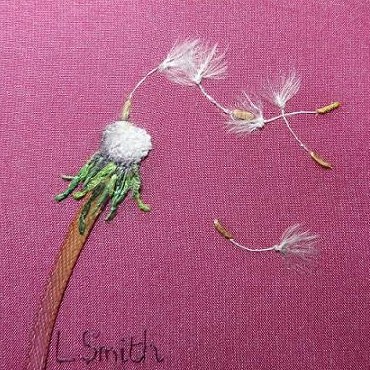 Another dandelion head worked in ribbons and thread, 2.25 inches x 2.25 inches. Here’s a link to my dandelion how-to posts.
Another dandelion head worked in ribbons and thread, 2.25 inches x 2.25 inches. Here’s a link to my dandelion how-to posts.
 Another dandelion head worked in ribbons and thread, 2.25 inches x 2.25 inches. Here’s a link to my dandelion how-to posts.
Another dandelion head worked in ribbons and thread, 2.25 inches x 2.25 inches. Here’s a link to my dandelion how-to posts.
2.25 x 2.25 inches, thread and ribbon on hand-painted silk. Here’s a link to previous posts that describe how I create dandelions using thread and ribbon.
And in event news, there will be an Event! The first since January! I’ll show some pieces in Positively Petite at Place des Arts, Coquitlam, BC, which runs November 13 to December 19, 2014.
3 x 4 inches, hand stitching on hand-painted silk.
That’s the sun, not the moon…there happened to be some dramatic sky action the day I took the photos inspiring this piece. (It’s a view from the ferry somewhere between Swartz Bay and Horseshoe Bay, BC).
I left the silk free of paint for the circle of the sun. The rest of the colour is gradually built up by painting with half-dry paint. And I think I used about 12 different shades of shiny thread for the water. Yet I still want more : )
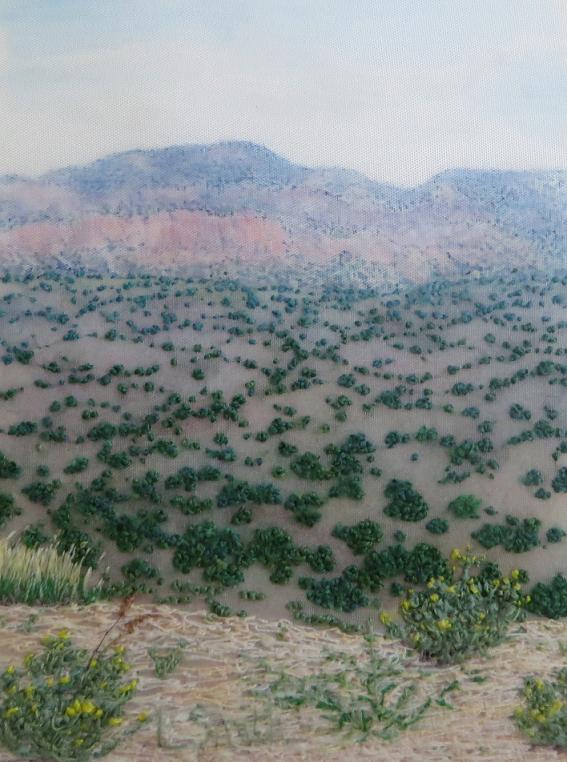
2.75 x 3.75 inches, free motion machine embroidery and hand sewing on hand-painted silk.
This is a view of mountains north of Santa Fe, New Mexico, a wonderful destination for art lovers. I’d expected the city to be a bit barren vegetation-wise but it was a lovely surprise to see native plants all over the place, and plenty of birds and butterflies.
I used machine embroidery only for the foreground rock. The rest is hand-sewn – I used embroidery floss and even some serger thread to give me more bulk quickly. I chose colours that graduate from warmer and darker in the foreground to cooler and paler in the distance, and also used a few tiny dabs of white pastel dye stick on thread in the very far distance to help get a hazy look. You iron on the pastel to set it.
It’s been so long since I did a blog post, I decided to do two at once. The post below contains all you ever wanted to know about painting dandelion stems but were afraid to ask. Sweet dreams!
This is a companion piece to Dandelion Seeds Step by Step. Here’s how I paint the stems.
I start with lengths of ribbon. I buy it on small rolls from a dressmaking shop and cut it into 6-inch lengths. This ribbon’s 5 mm wide but sometimes I use wider depending on the scale of the picture I want to make.
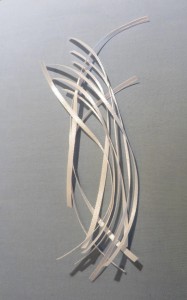
I always mix my paint shades from the colours below (cyan, hermes red, medium, primary yellow and ebony). You can buy lots more premixed shades but I prefer to make my own. The medium (white) doesn’t work as a white colour exactly, but as a dilutant for other colours. If you paint it on the silk, it appears clear rather than white.

Some dandelion stems are green, some red, and some a blend of both. I like the blend. Here I’ve mixed up a dark red to start me off. You’ll see from the dirty state of my “white” that I’ve diluted the colour as well. I want it nice and liquid so that it flows easily along the ribbon.

Silk paint dries fast, so you have to work quickly. If you don’t, sections of the paint start to dry and you get tidemarks.
I apply the paint with my little brush, starting at the end of the stem and working towards the middle. Every few strokes, I dip the brush in the white and stir it into the mix. This keeps it liquid, and the colour becomes lighter as you do this, which helps create the blend between the red and green shades. Painting a brushful or two of white onto the faded end of the red colour will blend it into nothing.

Then do the same with green on the other ends of the stems. Where the green and red overlap slightly you get a soft brown.

Here my brush is loaded with slightly drier paint and I’m running it down the edge of the stem. The resulting darker edge helps give the illusion of a cylindrical stem.

Then I paint over the stem with the same colours, still nice and wet, anywhere I want more intensity. You can do this as many times as you like.

I deliberately paint lengths of ribbon that are longer than the stems I need. This way, I can choose the part of the stem I think came out best to use in a picture.
In the same session I paint some ribbons different shades of green, and some a golden brown. No need for any shading on these. They are then cut into narrower strips and used in place of thread to create sepals and seed pods.

Once the ribbons are dry, don’t forget to iron them to fix the paint. I do them on high for three minutes. You can always paint over them again if you need to, as long as you re-iron the painted area.

Hmm, the title is almost bigger than the picture…this one’s only 1.25 x 2.75 inches. Hand stitching on a hand-painted charmeuse background. The structure sticking out of the water is some kind of depth marker or maybe to warn of rocks below.
There are all sorts of colours besides blue in water, you soon find. That said, I’ve decided my next picture will be Not Generally Blue!
This picture of a North Sea trawler is 4.25 x 5.5 inches.
The sky is purposely featureless; I wanted this to be all about the water. All the sewing is by hand, but if you look closely you’ll see that the trawler is made of pieces of hand-painted ribbon, glued or stitched to the background. The bow wave is some chopped-up yarn and the rigging is thread, mostly half-thickness.
The seagulls were a bit of a saga. Initial experiments with silk resulted in a frayed mess, and I felt thread would be too bulky. I decided I wanted Tyvek for its acid-free, non-fraying qualities, and ordered samples from a couple of suppliers ages ago…but I’m still waiting. I discovered FedEx use Tyvek for their envelopes, though, so I got hold of one and it turned out to be ideal. I tried cutting tiny gull shapes out of it, but found that I got the most natural-looking results by cutting two separate wings and overlapping them slightly. And I still have enough envelope left for a lifetime’s worth of seagulls.
More than any I’ve done before, this piece changes appearance depending on the light. Any direct light will pick up the sheen of the threads like crazy, as above. So I’ve included a shot below of the picture in more dull lighting. You’ll notice the gulls stand out more and it looks quite grim.
I’ll be honest – this blog post is pure fluff.
Okay…just had to get that pun out. I feel much better now.
So, this is part one of the very long answer to the question, how do you create your dandelion clock pictures? I plan on going into the details of other aspects such as background painting, background stitching, ribbon work, etc., in the future. This post focuses on the seeds.
I may upgrade the photos later, as some aren’t the sharpest.
I start with Gutermann sewing thread in shade No. 21, a nice soft white.

Then cut a length of about 12 inches or so.
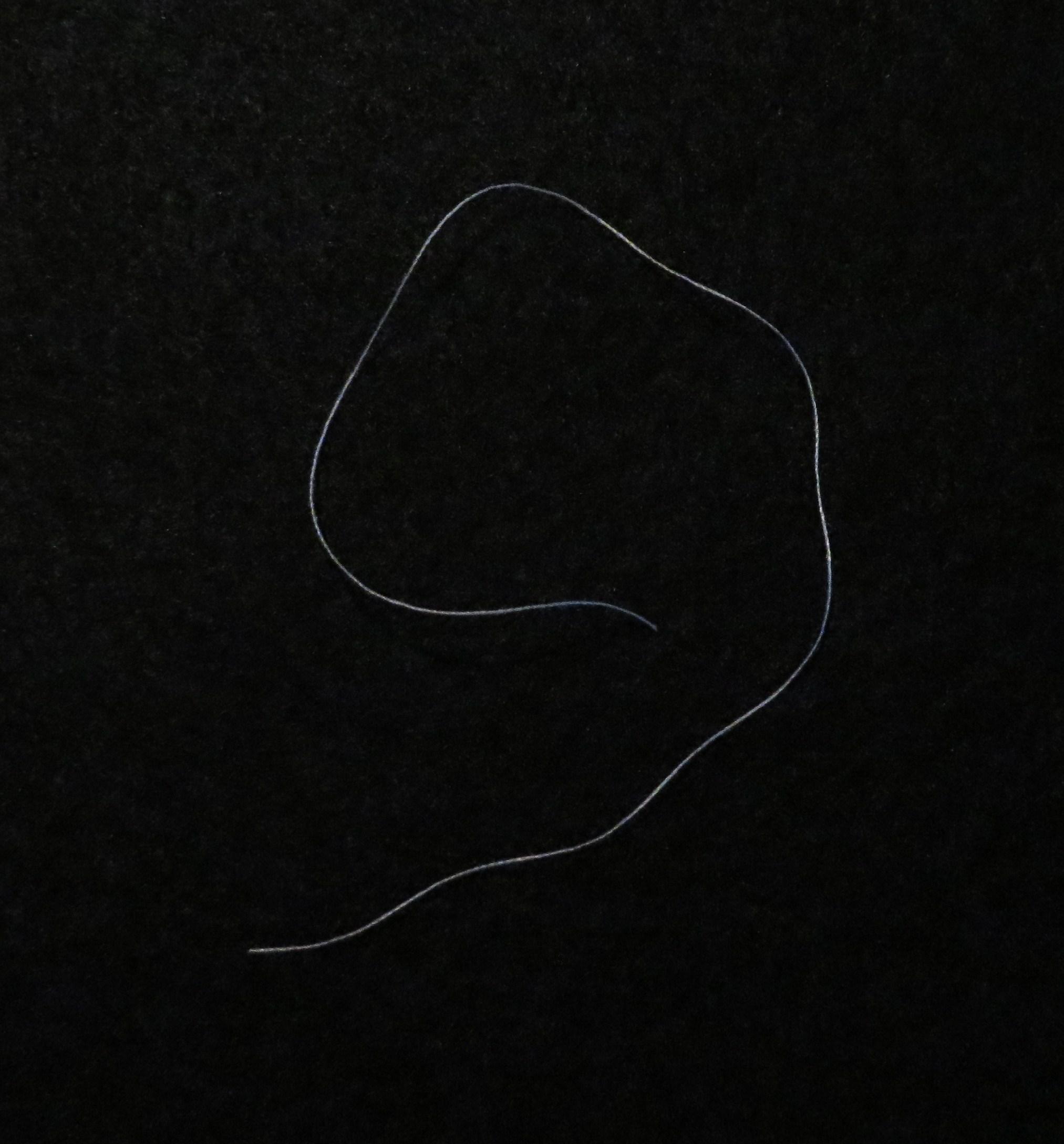
Tie single knots, spaced about 3/4 inch apart. No need to be exact about that.

You end up with bits. Sometimes there’s more thread on one side of the knot than on the other, and that’s okay.

Choose a bit. This type of thread is made up of two thinner threads twisted together. Roll it between finger and thumb against the direction of twist, and you’ll see it start to split apart.

Then you can grasp the ends and pull them apart all the way down to the knot.
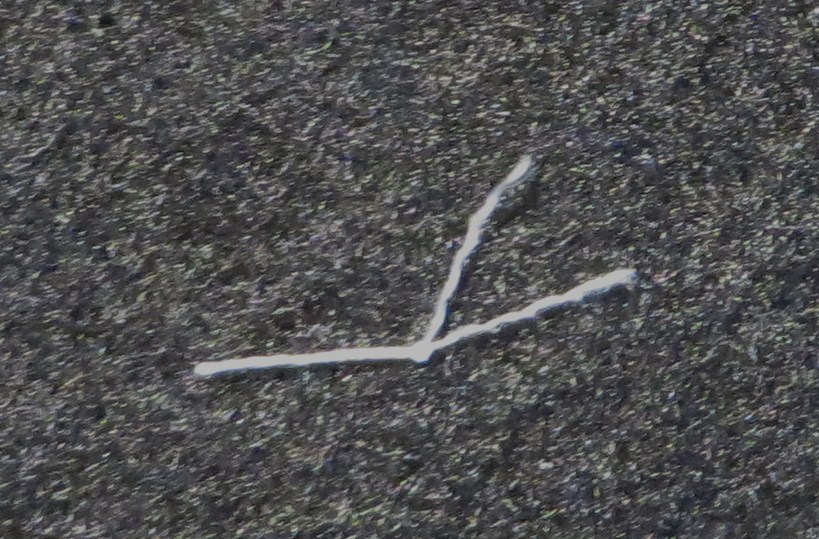
Enter the hero. He’s about 1 1/2 inches long and nice and sharp. I tie bright-coloured thread to the eye so that I can find the needle more easily if I drop it. (There have been Incidents).
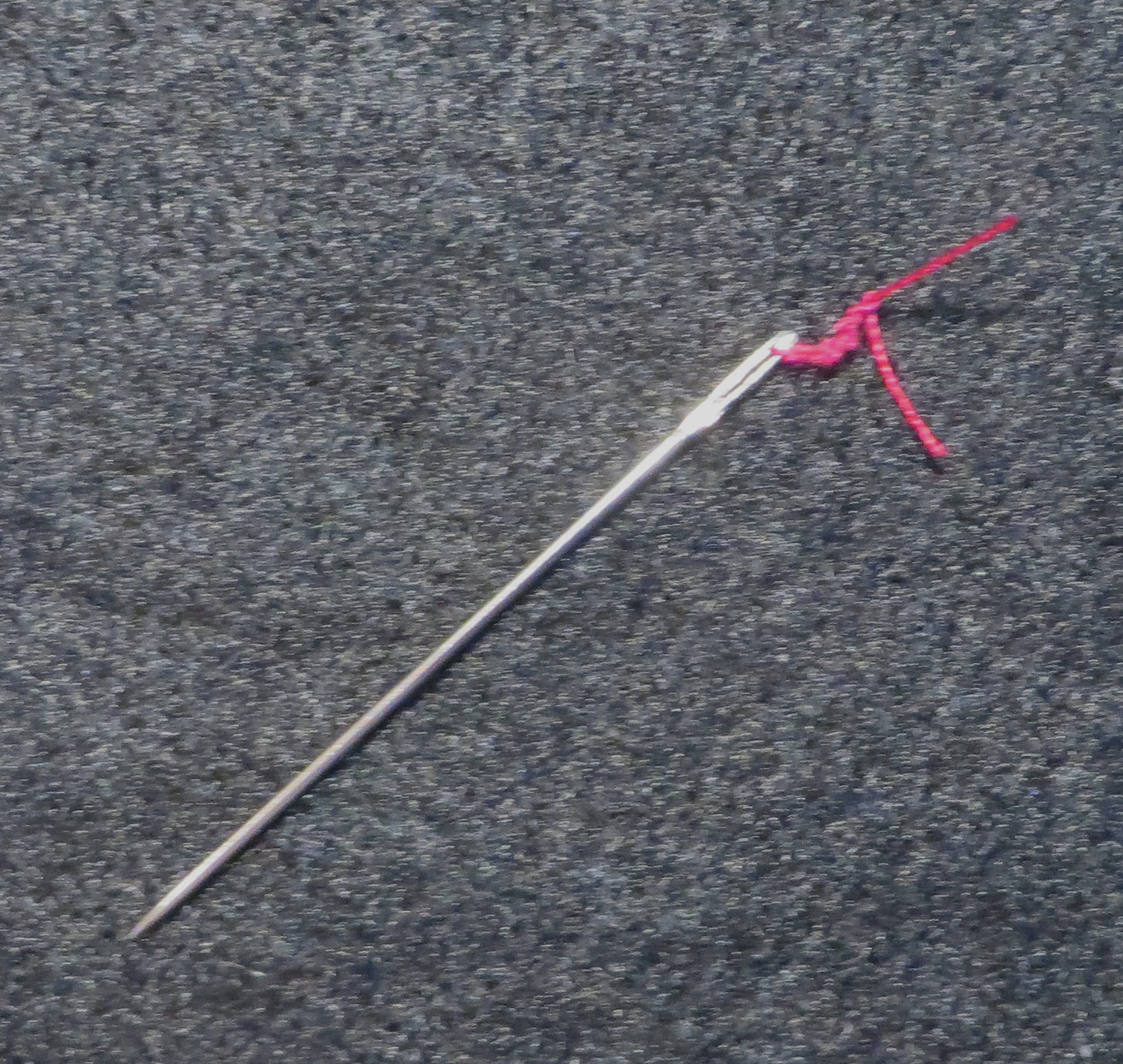
Next I grip the full-thickness end of the thread between finger and thumb. The newly-separated half-thickness threads rest against my fingertip. I use the needle to “comb through” and tease out each half-thickness thread until it’s separated out strand by strand. It’s a bit like trying to comb through tats in hair. You have to take your time, be gentle and not prick yourself, and do this under a good light.

The same with the other half-thickness thread.
I know, I know. I’m an artist, not a professional photographer : )

You can probably just about see in the photo above that the strands are quite wavy or crimped-looking. I like to iron them straight. The picture below shows me ironing one seed, but I usually lay out a great number and iron them all at once.
While I have the iron out I also like to take a few 10-inch lengths of thread, separate them into two half-thickness threads, and iron these straight. I use these straightened threads to form the “handles” to the seed “umbrellas” later.
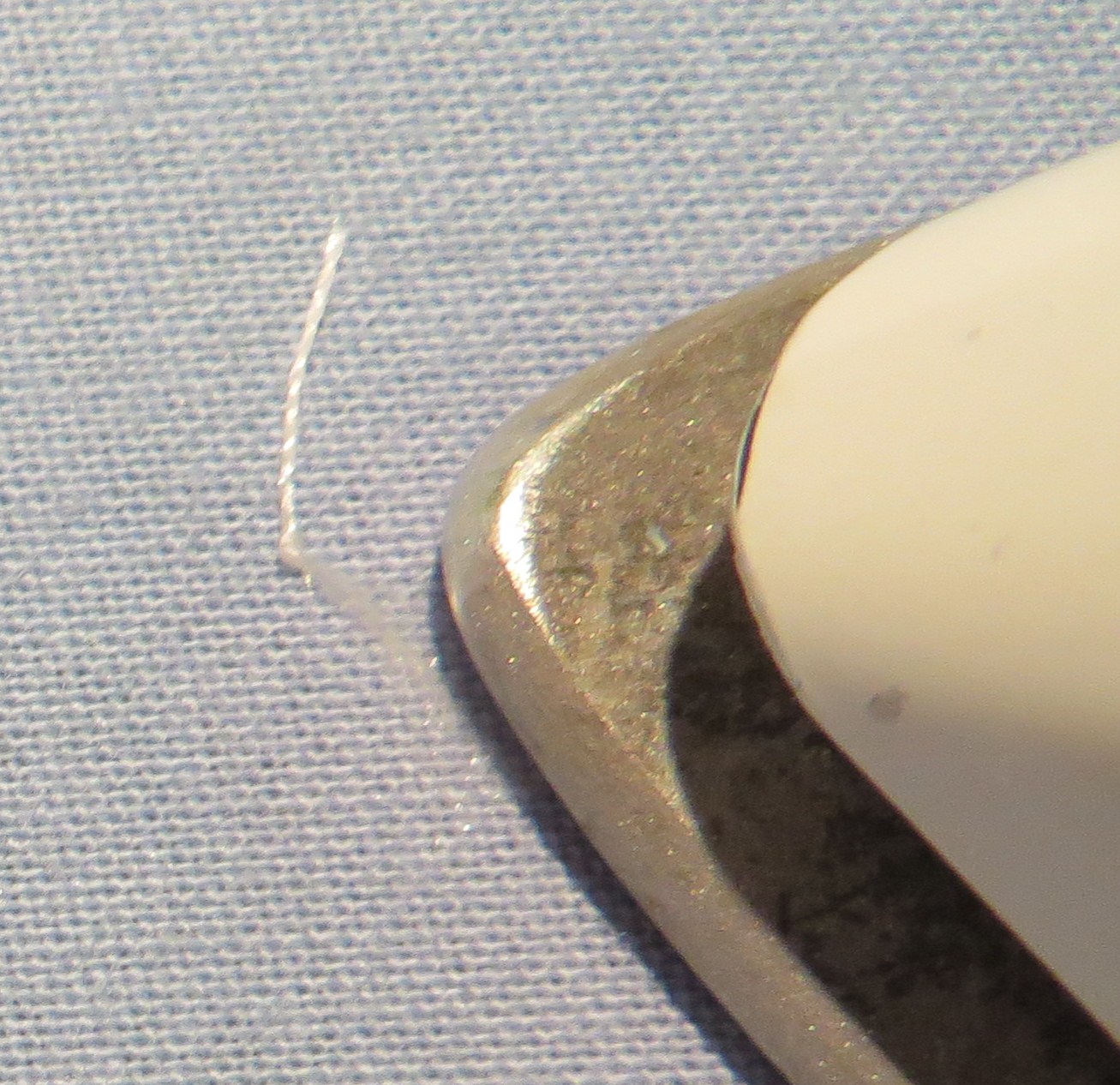
Now the strands are straighter.

Next I use scissors to trim the fluff into a more curved, dandelion seed shape.
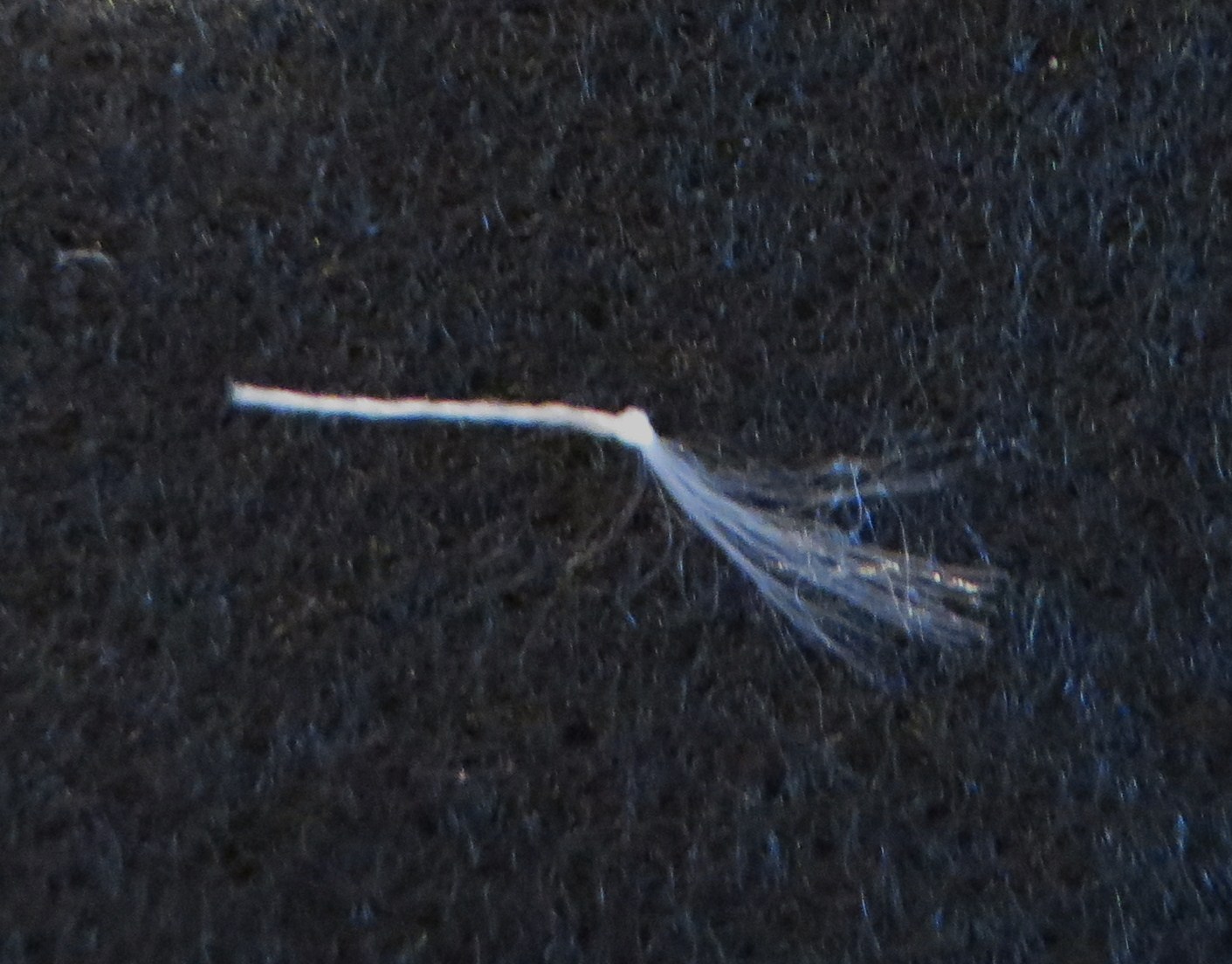
Then I snip off the full-thickness strand, as close to the knot as possible.

The fluff is now ready to be glued to the background. I use Aleene’s Acid-Free Tacky Glue. I usually apply a tiny dab to the knot, and it’s enough to keep it in place.
If it’s important to glue the strands as well, I apply glue very sparingly to a toothpick end, stroke it underneath the strands, and gently press them down. You have to be careful not to get glue on the silk where it’s not hidden by the fluff, because it can leave a slight discoloration.
As described above, I use half-thickness thread, ironed straight, to form the “handles” to these fluff umbrellas. I thread this through a fine needle, poke it right through the knot of the fluff, make a stitch in the direction I want, and use a securing thread or two to hold the stitch in a nice natural-looking bend.
Then I use a hand-painted strip of ribbon to create the brown part that attaches the seed to the head of the plant, but I’ll go into the ribbon painting on a different blog post.
Some of these steps are easily started and stopped in an odd five minutes here or there. I usually carry a little bag of “bits” and a needle with me so I can work on them during those times when life keeps you waiting about. This way, lots of unconnected journeys, delays and TV programmes can end up going into any one picture of a dandelion clock. And yes, the whole double meaning of these segments of time making up a dandelion clock doesn’t escape me, and sounds a lot like a possible theme for an exhibition. But all in good time.
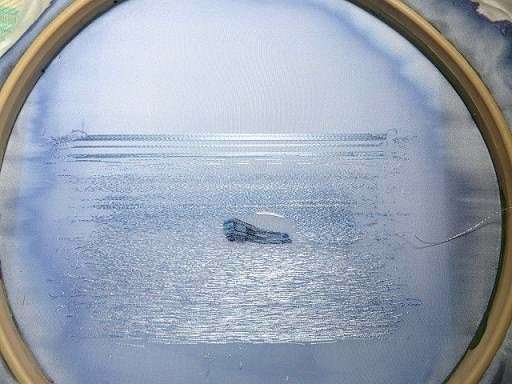
I haven’t completed any new pictures in a while but have been working on some long-term projects, while also dealing with property renovation and an apartment move. So it’s been nice in my few spare hours to work on something as peaceful as ocean waves. When it grows up, this is going to be a picture of a trawler with lots of seagulls flapping around.
I also took some inspiration photos on a recent trip to Victoria, BC…the weather gave me lots of great drama.